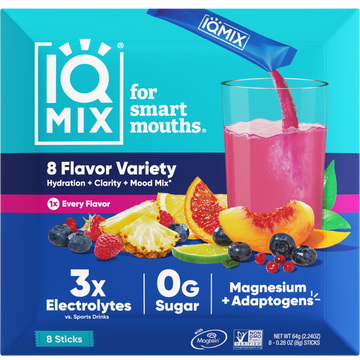If you get blood tests to assess your electrolyte levels and they come back within the “normal” range, everything is hunky-dory, right? Eh, not so fast.
While an electrolyte panel does give you an insight into the electrolytes in your bloodstream, it doesn’t give you the whole story about whether you’re taking in the optimal amount of electrolytes (through your diet) to support peak performance and well-being.
Confused? Don’t worry. We’re going to break down why electrolyte blood tests aren’t reliable for assessing your nutritional status of electrolytes and how to properly do so. Let’s dive in.
What Are Electrolytes?
Before we delve into the nuances of electrolyte assessment and management, let’s take a moment to untangle what exactly we mean when we talk about electrolytes.
Electrolytes are minerals that carry an electrical charge. These tiny, charged particles whiz around in our bodies, conducting electrical impulses that influence our heart rhythms, muscle function, and even how our brains operate. They also play a key role in managing fluid balance (aka hydration).
The key players in the electrolyte family are sodium, potassium, calcium, bicarbonate, magnesium, chloride, and phosphate. Each of these electrolytes has its own unique role and responsibility in the body, but they all work together in a delicate balance to keep us in tip-top shape.[*]
You lose electrolytes every day through sweat, urine, and feces. On a bad day, you can also lose electrolytes through vomit. These electrolytes must be replaced through the foods and drinks you consume.
Understanding Electrolyte Imbalance
When people get a blood electrolyte test (ordered by a doctor) and their test results come back normal, they think that means their electrolyte levels are perfectly balanced. This isn’t necessarily the case.
Just because your electrolytes aren’t completely out of whack doesn’t mean they’re optimized. To understand this, let’s go over the difference between electrolyte imbalance and electrolyte deficiency.
An electrolyte imbalance occurs when the levels of a particular electrolyte in your blood are either too low or too high. This is a serious medical condition that will show up as an out-of-range result on a blood test. If not promptly treated, an electrolyte imbalance can be life-threatening.
An electrolyte imbalance can be triggered by conditions or factors such as:
- Kidney disease or heart failure
- Illness-induced vomiting or diarrhea (can lead to a potassium imbalance, aka hypokalemia)
- Use of diuretic medications
- Excessive alcohol consumption
- Overhydration with plain water (may induce a sodium imbalance, aka hyponatremia)
Note that a diet low in electrolytes is not listed among these causes. If your diet is too low or high in electrolytes, that may contribute to an out-of-range result, but diet alone is rarely the primary driver of an electrolyte imbalance.
Understanding Electrolyte Deficiency
An electrolyte deficiency, on the other hand, refers to a dietary intake of a particular electrolyte that falls short of what your body requires for optimal functioning. In other words, your electrolyte levels aren’t completely out of whack (electrolyte imbalance), but they are not ideal. This can lead to a variety of symptoms (which we’ll cover shortly).
This deficiency won’t show up as out-of-range on a standard blood test. There are specialty tests that can check for optimal electrolyte levels, but these tests aren’t typically covered by health insurance.
How to Assess Your Electrolyte Status
Fortunately, you can evaluate your electrolyte status on your own by considering signs, symptoms, and dietary intake. We’ll focus on three of the most important electrolytes: sodium, potassium, and magnesium.
Sodium
Sodium plays a crucial role in the body by maintaining fluid balance, aiding in nerve transmission and muscle contractions, and regulating blood pressure and volume.
So, how do you know if you’re getting enough sodium in your diet? Here are the key areas to consider:
- Symptoms: Sodium deficiency often presents as fatigue, headaches, muscle cramps, and brain fog.
- Diet: Consider your diet. Whole food diets, whether vegan or keto, are naturally low in sodium. Plus, low-carb diets increase sodium loss through urine.[*] You can track your food intake via an app like Cronometer to determine how much dietary sodium you’re consuming. A good evidence-based target is 4-6 grams daily.[*]
- Sweat loss: Consider how much you sweat. When you sweat, you not only lose water, but also sodium. So, the more sweat you lose, the more sodium you’ll need to take in. For reference, athletes exercising in the heat can lose up to 7 grams of sodium daily![*]
Potassium
Potassium is vital for maintaining proper heart and muscle function, conducting nerve impulses, and balancing fluids and electrolytes within the body.
So, how do you know if you’re getting enough potassium in your diet? Here are the key areas to consider:
- Symptoms: Signs of potassium deficiency can include muscle weakness or cramps, constipation, tiredness, and malaise.
- Diet: Track your daily food intake using an app like Cronometer to determine how much potassium you’re getting through your diet each day. An optimal amount is 3.5-5 grams daily.[*]
- Sweat loss: As with sodium, potassium is lost through sweat. The more you sweat, the more potassium you’ll need to take in.
Magnesium
Magnesium plays a pivotal role in the body by facilitating hundreds of biochemical reactions, including those involved in nerve function, muscle contraction, maintaining a steady heartbeat, and supporting immune system health.
So, how do you know if you’re getting enough magnesium in your diet? Here are the key areas to consider:
- Symptoms: Signs of magnesium deficiency can include muscle cramps, constipation, tiredness, high blood pressure, increased inflammation, heart palpitations, and cardiac arrhythmias.
- Diet: Track your daily food intake using an app like Cronometer to determine how much magnesium you’re getting through your diet each day. Aim for 400-600 mg daily.[*]
Small amounts of magnesium are also lost through sweat, but symptoms and diet are the big two to focus on for this electrolyte.
How to Improve Your Electrolyte Status
To treat your electrolyte deficiency, or reduce your risk of developing one, follow these simple tips:
- Embrace your salt shaker: Sodium deficiency is surprisingly common, especially for folks who are very active, eat a whole foods diet, or follow a low-carb diet. To combat this, liberally salt your food. Remember, 4-6 grams of sodium daily is ideal (that’s about 2-3 teaspoons).
- Load up on electrolyte-rich foods: Focus on adding electrolyte-rich foods to your meals, including leafy greens, celery, avocado, beans, nuts, sweet potato, and seeds.
- Drink electrolyte water: Consider adding a high-quality electrolyte powder, such as IQMIX, to your water. IQMIX provides a balanced blend of essential electrolytes (sodium, potassium, and magnesium) in a convenient, tasty format. Only drink water to thirst, as drinking excessive amounts of water can dilute your electrolyte levels, especially if drinking plain water.
Psst!: IQMIX is ideal for those with diabetes or those following a low-carb diet, as it contains zero sugar and only 3 grams of carbs per packet. Compare that to your typical 16-ounce sports drink, which contains between 28 and 38 grams of added sugar—equal to about 7 to 10 teaspoons! Learn more about why hydration drinks don’t need to contain glucose (sugar) to be effective here.
Relishing in the Results
How will you know if you’ve improved your electrolyte balance? The answer is simple: you’ll feel it! Your symptoms will fade away and your energy will improve. No blood tests required!
Of course, if you’re experiencing severe symptoms or you’ve been experiencing symptoms for a long time, it’s important to get checked out by your healthcare provider. If they can’t find anything wrong, dialing in your electrolyte intake is certainly worth exploring!
Written by Katie Koschalk, a health and wellness writer, certified holistic nutritionist, and certified personal trainer based in California.




